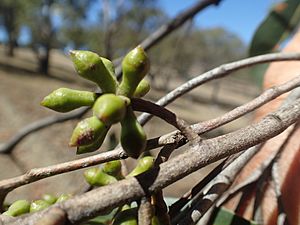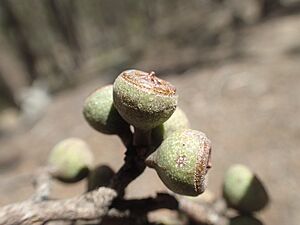New England stringybark facts for kids
Quick facts for kids New England stringybark |
|
|---|---|
 |
|
| Flower buds of Eucalyptus caliginosa | |
| Scientific classification | |
| Genus: |
Eucalyptus
|
| Species: |
calignosa
|
| Synonyms | |
|
Eucalyptus cyathiformis Blakely |
|
Eucalyptus caliginosa, also known as the broad-leaved stringybark or New England stringybark, is a special tree that grows only in eastern Australia. It's easy to spot because of its unique stringy bark. This tree has long, curved leaves, and its flower buds grow in small groups. When it blooms, it has pretty white flowers, and then it produces round fruits. You can commonly find this tree in the Northern Tablelands and North West Slopes of New South Wales and nearby areas of Queensland.
What Does It Look Like?
The New England stringybark is a tall tree, usually growing about 25 to 35 meters (82 to 115 feet) high. It has a special woody swelling at its base called a lignotuber. This helps the tree regrow if it gets damaged, for example, by fire.
The bark of this tree is rough and stringy. It's usually grey to reddish-brown and covers even the smaller branches.
- Leaves:
- Young plants and new shoots (called coppice regrowth) have leaves arranged in pairs. These leaves are egg-shaped to broadly lance-shaped. They are about 35 to 100 millimeters (1.4 to 3.9 inches) long and 13 to 45 millimeters (0.5 to 1.8 inches) wide.
- Adult leaves grow one after another along the stem. They are shiny green on both sides and shaped like a lance or slightly curved. These leaves are 50 to 180 millimeters (2.0 to 7.1 inches) long and 13 to 35 millimeters (0.5 to 1.4 inches) wide. Each leaf has a stalk called a petiole, which is 8 to 20 millimeters (0.3 to 0.8 inches) long.
- Flowers and Fruit:
- The flower buds grow in groups of seven or nine. Each group is on a stalk called a peduncle, which is 5 to 15 millimeters (0.2 to 0.6 inches) long. Each individual bud has a tiny stalk called a pedicel, about 1 to 4 millimeters (0.04 to 0.16 inches) long.
- Mature buds are shaped like a spindle or an oval. They are 5 to 6 millimeters (0.2 to 0.24 inches) long and 2 to 4 millimeters (0.08 to 0.16 inches) wide. Each bud has a cone-shaped cap called an operculum.
- This tree flowers between March and October, and its flowers are white.
- After flowering, the tree produces fruit that are shaped like a half-sphere or a flattened sphere. They are 4 to 6 millimeters (0.16 to 0.24 inches) long and 6 to 8 millimeters (0.24 to 0.31 inches) wide. The rim of the fruit is flat or slightly curved outwards. Inside, there are three or four sections (called valves) that are level with the rim or slightly raised.
- The seeds are brown, shaped like a pyramid, and very small, about 1 to 2 millimeters (0.04 to 0.08 inches) long.
Its Name and History
The Eucalyptus caliginosa was first officially described by two botanists, William Blakely and Ernest Norman McKie, in 1934. They wrote about it in Blakely's book, A Key to the Eucalypts. The first example specimen of this tree that was studied (called the type specimen) was found near Guyra.
The scientific name caliginosa comes from a Latin word. It means "foggy," "misty," or "dark."
Where Does It Grow?
The New England stringybark is commonly found on ridges and hilltops. You can see it in south-eastern Queensland, and across the Northern Tablelands and North West Slopes of New South Wales.
It usually grows in dry sclerophyll forests, open woodlands, or grassy forest areas. It prefers loamy soils that are moderately fertile. You can find it north of places like Yarrowitch and the Liverpool Range, stretching all the way to Stanthorpe in southern Queensland.
-
Eucalyptus caliginosa growing near Armidale
-
A Eucalyptus caliginosa tree that was struck by lightning in Walcha
See also
 In Spanish: Eucalyptus caliginosa para niños
In Spanish: Eucalyptus caliginosa para niños





